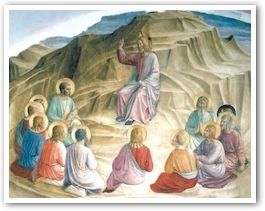Did Jesus have Brothers and Sisters?
- FR. WILLIAM SAUNDERS
In the New American Bible's English translation of the Gospel of St. Mark we do indeed read about the crowd asking, "Isn't this the carpenter, the son of Mary, a brother of James and Joses and Judas and Simon? Aren't His sisters our neighbors here?" (Mk 6:3)
 |
The problem emerges in understanding the meaning of the word adelphos, brother. In the original text of the Gospel, we find the Greek word adelphos meaning brother, used. However, does not just mean blood brothers born of the same parents. Rather, adelphos was used to describe brothers not born of the same parents, like a half-brother or stepbrother. The word also described other relationships, like cousins, nephews, etc.
For example, in Gn 13:8 and 14:1416, the word adelphos was used to describe the relationship between Abraham and Lot; however, these two men did not share a brother relationship, but one of uncle and nephew. Another instance is that of Laban, who was an adelphos to Jacob, not as a brother, but as an uncle. (In the New American translation, "kinsman" or "relative" will be used in these Old Testament cases; I do not know why this is not true in the English translation of the Gospel.) The same is true for the word sister.
Actually, the confusion originates in Hebrew and Aramaic, the languages of most of the original Old Testament texts and of Christ. In these languages, no special word existed for cousin, nephew, half-brother, or step-brother; so they used the word brother or a circumlocution, such as in the case of a cousin, "the son of the brother of my father." When the Old Testament was translated into Greek and the New Testament written in Greek, the word adelphos was used to capture all of these meanings. So in each instance, we must examine the context in which the title is used. In all, the confusion arises in English because of the lack of distinct terms for relatives in the Hebrew and Aramaic, and the usage of the Greek adelphos to signify all of these relations.
Nevertheless, other Gospel passages clarify these relationships. James and Joses were the sons of Mary of Clophas (Mk 15:40). Judas was the son of James (not either of the Apostles) (Lk 6:16). James the Lesser was the son of Alphaeus (Lk 6:15). James the Greater and John were the sons of Zebedee with a mother other than our Blessed Mother Mary (Mt 20:20).
The Gospels are also very clear that Mary was a virgin at the time she conceived Jesus through the power of the Holy Spirit (cf. Mt 1:18-25, Lk 1:26-38). Remember when the Archangel Gabriel announced to Mary God's plan, she responded, "How can this be, since I do not know man?"
After the birth of our Lord, although the Gospels do not give us many details of His childhood, no mention is made of Mary and Joseph ever having other children. Never does it refer to the "sons of Mary" or "a son of Mary," but only the son of Mary.
This point is again corroborated at the crucifixion scene: Before He dies, our Lord says to Mary, "Woman, there is your son," and then to St. John, who is definitely not a blood brother, "There is your mother."
According to Jewish law, the oldest son had the responsibility of caring for the widowed mother, and that responsibility would pass to the next oldest if anything happened to the first-born son. By this time, St. Joseph has died. Since Jesus, the first born, had no "blood brother," He entrusted Mary to the care of St. John, the Beloved Disciple. Interestingly, the Orthodox Churches solve this problem over brothers and sisters by speculating that St. Joseph was a widower who had other children before he married Mary. These brothers and sisters would really then be half-brothers and half-sisters. Perhaps this notion is why St. Joseph sometimes appears elderly in paintings. Actually, this whole confusion is not new. About 380, Helvidius suggested that the "brethren" were the children born of Mary and Joseph after Jesus. St. Jerome declared this as a "novel, wicked, and daring affront to the faith of the whole world." In his On th e Perpetual Virginity of the Blessed Mary, St. Jerome used both Scripture and the fathers, like Saints Ignatius, Polycarp, Irenaeus and Justin Martyr to refute Helvidius. Later, the First Lateran Council (649) definitively declared that Mary was "ever virgin and immaculate."
Therefore, as Catholics, based on Sacred Scripture and Tradition, we do not believe that Mary and Joseph had other children and consequently that Jesus had blood brothers and sisters.
 This is Meaghen Gonzalez, Editor of CERC. I hope you appreciated this piece. We curate these articles especially for believers like you.
This is Meaghen Gonzalez, Editor of CERC. I hope you appreciated this piece. We curate these articles especially for believers like you.
Please show your appreciation by making a $3 donation. CERC is entirely reader supported.

Acknowledgement
Saunders, Rev. William. "Did Jesus have Brothers and Sisters?" Arlington Catholic Herald.
This article is reprinted with permission from Arlington Catholic Herald.
The Author

 Father William Saunders is pastor of Our Lady of Hope parish in Potomac Falls, Virginia. He is dean of the Notre Dame Graduate School of Christendom College. The above article is a "Straight Answers" column he wrote for the Arlington Catholic Herald. Father Saunders is the author of Straight Answers, a book based on 100 of his columns, and Straight Answers II.
Father William Saunders is pastor of Our Lady of Hope parish in Potomac Falls, Virginia. He is dean of the Notre Dame Graduate School of Christendom College. The above article is a "Straight Answers" column he wrote for the Arlington Catholic Herald. Father Saunders is the author of Straight Answers, a book based on 100 of his columns, and Straight Answers II.




